#granodiorite
Text


~ Statue of Lady Sennuwy.
Period: Middle Kingdom, 12th Dynasty, reign of Senusret I
Date: ca. 1971-1926 B.C.
Place of origin: Lower Nubia (Sudan), Kerma, Tumulus K III.
Medium: Granodiorite
#ancient#ancient art#history#museum#archeology#ancient egypt#ancient sculpture#archaeology#ancient history#egyptian#egyptology#egypt#statue of lady sennuwy#middle kingdom#12th Dynasty#senusret i#nubia#sudan#kerma#granodiorite#ca. 1971 b.c.#ca. 1926 b.c.
519 notes
·
View notes
Text

Head of King Amenhotep II with the "Blue Crown"
Egyptian, 1427-1401 BCE (New Kingdom)
The khepresh, or "blue crown," appears frequently in royal sculpture of the New Kingdom. The king wore this crown on campaigns or in ceremonial processions. As with all royal headdresses, the coiled, protective uraeus serpent appears at the brow.
35 notes
·
View notes
Text

Head of the God Amun
Ca. 1336–1327 B.C.
New Kingdom, post-Amarna Period.
From Upper Egypt, Thebes; From Egypt.
Amun was a major ancient Egyptian deity who appears as a member of the Hermopolitan Ogdoad. Amun was attested from the Old Kingdom together with his wife Amunet. With the 11th Dynasty (c. 21st century BC), Amun rose to the position of patron deity of Thebes by replacing Montu.
After the rebellion of Thebes against the Hyksos and with the rule of Ahmose I (16th century BC), Amun acquired national importance, expressed in his fusion with the Sun god, Ra, as Amun-Ra (alternatively spelled Amon-Ra or Amun-Re).
Amun-Ra retained chief importance in the Egyptian pantheon throughout the New Kingdom (with the exception of the "Atenist heresy" under Akhenaten). Amun-Ra in this period (16th to 11th centuries BC) held the position of transcendental, self-created creator deity "par excellence"; he was the champion of the poor or troubled and central to personal piety. With Osiris, Amun-Ra is the most widely recorded of the Egyptian gods.
As the chief deity of the Egyptian Empire, Amun-Ra also came to be worshipped outside Egypt, according to the testimony of ancient Greek historiographers in Libya and Nubia. As Zeus Ammon and Jupiter Ammon, he came to be identified with Zeus in Greece and Jupiter in Rome.
#Head of the God Amun#Ca. 1336–1327 B.C.#New Kingdom post-Amarna Period#granodiorite#sculpture#egyptian sculpture#ancient artifacts#archeology#archeolgst#history#history news#ancient history#ancient culture#ancient civilizations#ancient egypt#egyptian history#egyptian art
141 notes
·
View notes
Text
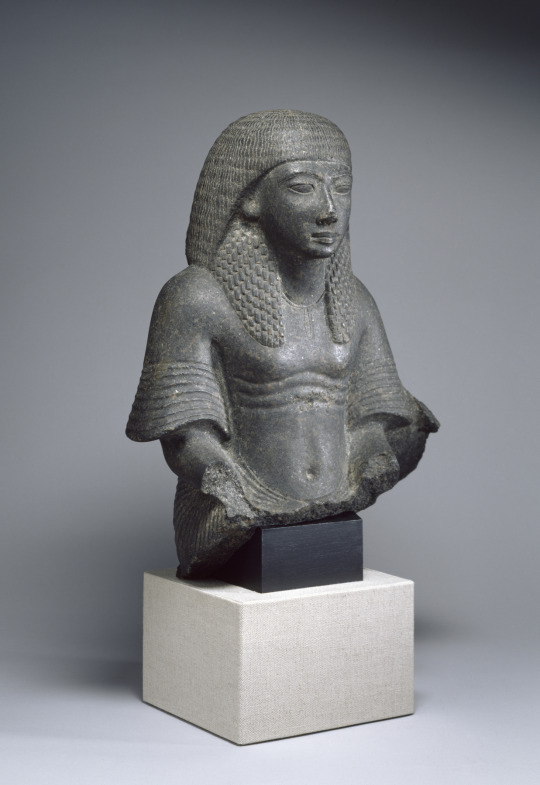
Ancient Egyptian male bust (granodiorite) of an official. Originally the man would have been shown together with his wife. Artist unknown; ca. 1300-1290 BCE (18th or 19th Dynasty, New Kingdom). Probably from the official's tomb at Saqqara; now in the Walters Art Museum, Baltimore. Photo credit: Walters Art Museum.
#art#art history#ancient art#Egypt#Ancient Egypt#Egyptian art#Ancient Egyptian art#18th Dynasty#19th Dynasty#New Kingdom#sculpture#portrait sculpture#portrait bust#granodiorite#stonework#carving#Walters Art Museum
162 notes
·
View notes
Text
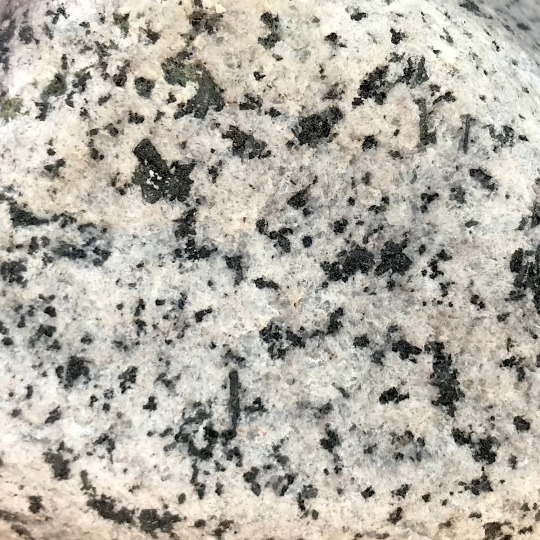
Close-up of granodiorite. NPS Photo
Landscape Language
Granodiorite (noun) – a coarse-grained igneous rock
Around 18-14 million years ago, long before the 500,000-year-old volcano Mount Rainier formed, a large mass of molten rock slowly cooled under the surface, forming granodiorite, a rock similar to granite. This granodiorite underlies the Tatoosh Range, White River, Carbon River, and Nisqually River Valleys. Outcrops of granodiorite can be viewed up-close along White River Road near the White River Campground (White River Road is estimated to open for the season May 26; the campground June 23).

Granodiorite outcrop along White River Road. NPS Photo
Tatoosh granodiorite rocks, rounded by water erosion, are common in the Nisqually River as well. You may even spot some granodiorite boulders used in the construction of historic structures like the Longmire Administration Building!


A light-colored granodiorite boulder in the Nisqually Rive (left) and granodiorite boulders around the front door to the Longmire Administration Building (right). NPS Photos
~kl
39 notes
·
View notes
Photo
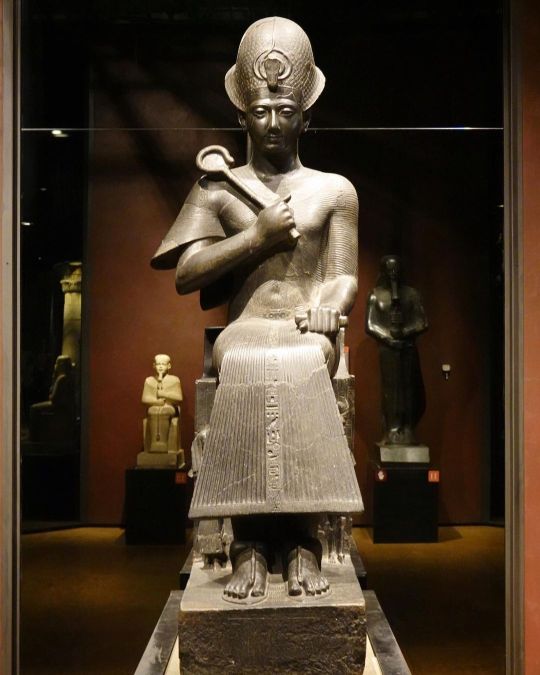
Granodiorite Statue of Ramesses II The king 𓇓𓏏𓈖 “nsw” is depicted in all his majesty. He wears the khepresh crown 𓆣𓂋𓈙𓋙 “ḫprš” and holds the heka sceptre 𓋾𓏘𓄿 “ḥq3” against his chest. His transparent pleated ceremonial dress reveals his muscled body 𓄡𓏏𓏤 “ẖ.t”. Under his sandals 𓍿𓃀𓏏𓋸𓋸 “tjbw.ty” he tramples the Nine Bows 𓌔𓏏𓐂 “psḏ.t”, symbols of the enemies 𓐍𓆑𓏏𓏭𓀏 “ḫfty” of Egypt. On the sides of the throne 𓊨𓏏𓉗 “3s.t” is carved the sema-tawy 𓋍, the knotted heraldic plants of Upper and Lower Egypt representing the union of the Two Lands 𓇾𓇾 “t3wy”. Dynastic continuity is expressed by the figures of his wife Nefertari (𓏏𓅐𓄤𓇋𓏏𓂋𓏭𓈘𓏏) “nfr-tı͗-rı͗-mrı͗.t-mwt” ‘Beautiful Companion, Beloved of Mut’ and his son Amunherkhepeshef on either side of his legs. The long reign of Ramesses lI (𓇳𓏤𓄟𓋴𓇓) “rˁ-msi-sw” ‘Him, Born of Ra’ probably witnessed a stylistic evolution of the royal portrait. The statue 𓂙𓏏𓏭𓀾 “ḫnty” probably belongs to the beginning of the reign of Ramesses I. In any case, it can be no later than the first half of the reign, due to the presence of Queen Nefertari, who died in year 30, This statue is one of the symbols of the @museoegizio In a letter that he wrote during his stay in Turin in 1824, Champollion describes with enthusiasm "the beauty and the admirable perfection of this colossal figure (….): for six whole months I have seen it every day, and always I have the impression of seeing it for the first time. The head is divine, the feet and hands are admirable, the body is voluptuous; I call it the Egyptian Apollo of the Belvedere... in short, I am in love with it”. Granodiorite. New Kingdom, 19th Dynasty, reign of Ramesses II (1279-1213 BC) Karnak, temple of Amon Drovetti Collection (1824). 📸 Richard Mortel - Flickr (Thank you) 𓋹𓎬𓋹𓎬𓋹𓎬𓋹𓎬𓋹𓎬𓋹𓎬𓋹𓎬𓋹𓎬𓋹𓎬𓋹𓎬𓋹𓎬𓋹𓎬𓋹𓎬𓋹𓎬 @egyptologylessons 𓋹𓊽𓋴𓆖𓎛𓇳𓎛 © 𓊁𓊁𓊁𓊁𓊁𓊁𓊁𓊁𓊁𓊁𓊁𓊁𓊁𓊁𓊁 #Ancientegypt #ägypten #egyptology #egypte #egitto #埃及 #مصر #egipto #이집트 #ramsesiii #egyptianstatue #granodiorite #pharaoh #turinmuseum https://www.instagram.com/p/CpilESKuK63/?igshid=NGJjMDIxMWI=
#ancientegypt#ägypten#egyptology#egypte#egitto#埃及#مصر#egipto#이집트#ramsesiii#egyptianstatue#granodiorite#pharaoh#turinmuseum
35 notes
·
View notes
Text
5 notes
·
View notes
Text
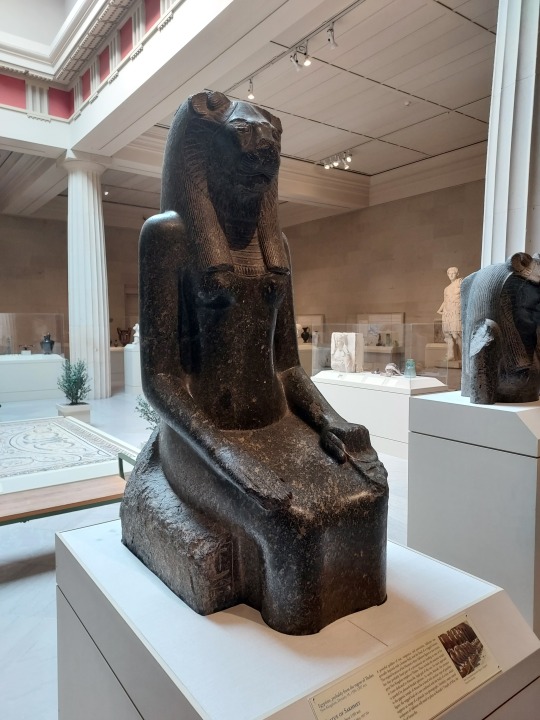

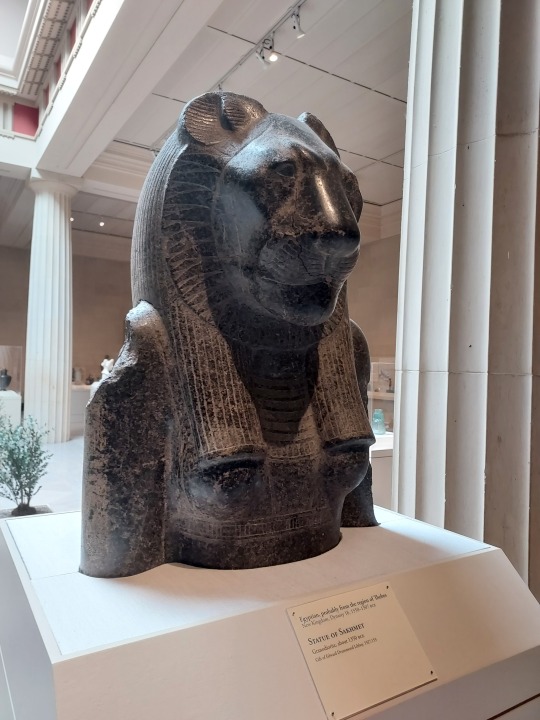
Three Statues of Sekhmet
About 1350 B.C.E (Dynasty 18)
Granodiorite
Egyptian
------------------------------------------
A powerful goddess of war, vengeance, and protection, Sekhmet was generally depicted with a human body and the head of a wigged lioness. The original location of these figures is not certain, but they probably lined and guarded part of a processional axis leading to one of the great New Kingdom temples at Thebes.
Located at The Toledo Museum of Art
4 notes
·
View notes
Photo

#photographers on tumblr#original photographers#black and white#nature#forest#trees#beeches#wolf gorge natural monument#granodiorite#přírodní památka vlčí rokle#hornopožárský les
4 notes
·
View notes
Text
ok ok listen. im reading a lot about TTG mafic swarms and dikes atm, mostly because this kind of archean rock is exctly the kind of rock i grew up on. i cant wait to go out into the archipelago later this summer to my familys summer place and bring some rock tools to go do some field stuff! the past two years-ish ive wondered about these pretty obvious flow structures right, these highly metamorphosed rocks with these seemingly random black swirls and dark patches/xenolith-like "inclusions" scattered around a particular part of the exposed rock face - and mostly they fold with the metamorph structure (or is it texture? sometimes its hard studying geology in two separate languages), but not always. and as ive read and pondered for a couple of months, i just need some fresh samples and to freshen up my memory to see if it is surely so. im pretty sure, though. and i find that really exciting.
0 notes
Text

Granodiorite cube with relief of Nebnefer, an official of the 18th Dynasty during the reign of Amenhotep III. The goddess on the front is Heathor.
New Kingdom, 18th Dynasty, ca. 1391-1353 BC.
From Sobek Temple in Sumenu northwest of Luxor.
Now in the Luxor Museum, J 136
144 notes
·
View notes
Text
Remarkable rocks of Pine Creek Pass, Sierra Nevada Mountains, California


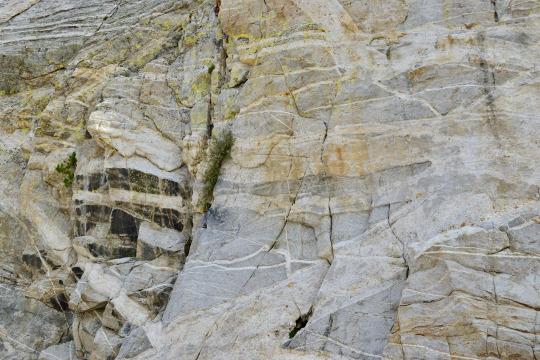



Pine Creek Pass is a less-used trailhead in the Eastern Sierra of California. It's a steep slog of about 3,500 vertical feet in about 6 miles, ending at just over 11,000 feet. The scenery is remarkable, but so are the rocks.
This an unnamed pinnacle of dark gabbro which has been intruded by younger granite bands. The gray cliff to the right is intruded by the same younger granite bands!
Fractures in the gabbro of the stripy mountain filled with feldspar crystals (formed when liquid). The lighter band is offset slightly by the white vein, which shows lateral movement across that vein when it was forming. These are called en-echelon fractures.
Younger granite intruding (as bands) older granodiorite and a xenolith eclogite inclusion - a chunk of unrelated rock carried by the original melted granodiorite (complex relationships here!).
Granodiorite polished smooth by the abrasive action of glaciers during the last Ice Age (~21,000 years ago in this area).
Outcrop of glacially polished granodiorite.
Glacially polished granodiorite with a thick intrusion (dike) of pink granite that has been offset laterally by a younger and thinner dike of different granite.
92 notes
·
View notes
Note
ummm that stone is massive, there's no way it could just "fall over". just say napoleon blew it off, we all know he used the sphinsx for target practice so why not this
a) the nose was documented to not be on the Sphinx in 1737, 61 years before Napoleon's invasion of Egypt. 32 years before Napoleon was born, in fact. The nose was deliberately hacked off sometime between the 3rd and 10th centuries AD, as the area around the nose bears hallmarks of tools.
b) several large earthquakes have occurred in Egypt (885 AD, 1068, and, if we're being pedantic, 1754). Many of the temples you see today have been restored to look like they did, but at one point were simply rubble and ruins. Things tend to fall over in earthquakes, especially if they've been left to ruin.
c) a cannon ball would have obliterated a stele made from granodiorite rather than simply breaking it in two cleanly. An impact pattern from a cannon ball hits in one place and then fans out, much like a bullet hitting glass. If such a thing hit the rosetta stone we wouldn't just have one section broken diagonally at the top, and a bottom corner missing.
d) someone's never heard of the Description de l'Égypte and it shows
282 notes
·
View notes
Text



AN EGYPTIAN GRANODIORITE HEAD OF AMUN
NEW KINGDOM, LATE 18TH DYNASTY, CIRCA 1336-1295 B.C.
#AN EGYPTIAN GRANODIORITE HEAD OF AMUN#NEW KINGDOM#LATE 18TH DYNASTY#CIRCA 1336-1295 B.C.#stone#stone sculpture#stone statue#ancient artifacts#archeology#archeolgst#history#history news#ancient history#ancient culture#ancient civilizations#ancient egypt#egyptian history#egyptian gods#egyptian art
102 notes
·
View notes
Note
imagine tumblr using a pestle and mortar like this: https://www.youtube.com/watch?v=6n3ULiBoqBk&t=131s
the video calls it a granite mortar when that is CLEARLY a diorite or at best a granodiorite and is visibly dominated by feldspar and iron bearing phases. lol. lmao.
#maybe brush up on your intrusive igneous composition classifications idiot. fool#not art#ask#icanfeelthethunder#geology#not me saying iron bearing phases and telling on myself for not being able to tell biotite from hornblende unless it’s in thin section#listen if that was a pegmatitic texture i would be on the classification of those dark phases in a heartbeat#but if i see black specks i have no way of avoiding putting my entire foot in my mouth saying it’s one thing and not the other#also if that was pegmatitic it would be a shit mortar#hey babe i made you some pesto. oh what are those black seasoning flecks you ask? silica crystals. eat up butch#bitch*#i hate autocorrect#socialstuck#twitblr
44 notes
·
View notes
Text
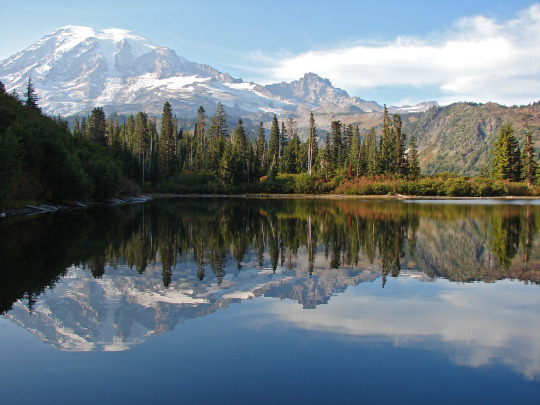
Bench and Snow Lakes trail is an out and back trail. No loop here. No alternatives. You start at the trailhead, hike out to Bench and/or Snow Lake, turn around and hike the same trail back. Some folks don’t like out and back trails because of this. It’s the same trail both coming and going. Some people prefer loop trails because you get to see something different all the way along. I would argue the same is true with Bench and Snow Lakes trail.
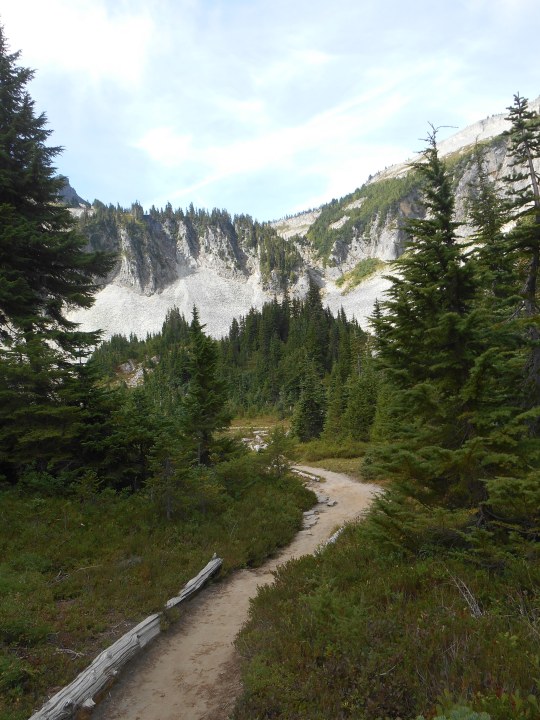
Bench and Snow Lakes trail is not the longest trail. It’s only about 2.6 miles roundtrip. It’s not the flattest or steepest trail in the park either, about 700 feet of elevation change total. But in a way, it’s like 2 different trails. Starting from the trailhead and going out, you’re moving through groves of trees and meadows and looking up to the Tatoosh Mountain Range. These beautiful mountains are made of granodiorite about 14-18 million years old.
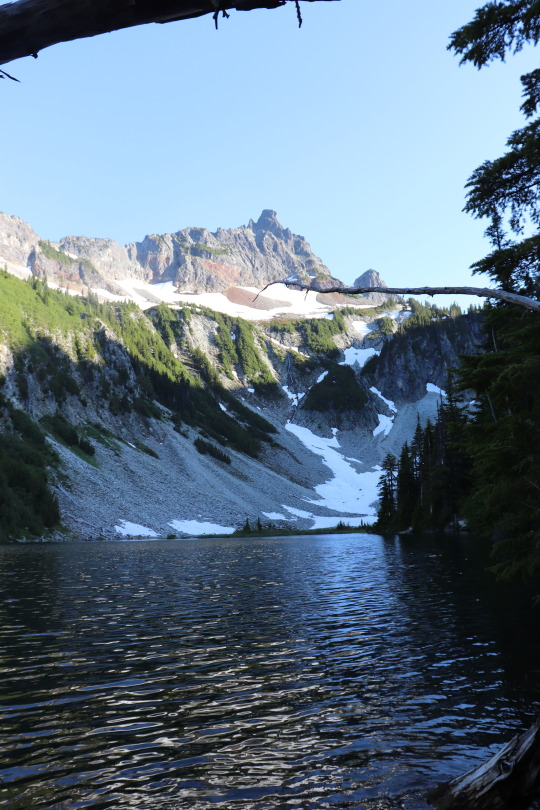
Less than a mile in, the trail brings you to the side of Bench Lake. Follow the trail further into the Tatoosh Mountains, you get a great view of one Tatoosh peak in particular. About half a mile from Bench Lake you’ll find Snow Lake nestled at the bottom of Unicorn Peak. And now for the second act, you turn around to hike back to your car at the trailhead. Along the way you get awesome views of Mount Rainier. It’s almost like a completely different trail. Which views are your favorite on the Bench and Snow Lakes trail? Do you prefer the more ancient Tatoosh Range or the young volcano towering over 14,000 feet above sea level? ~ams

For more information on this trail https://www.nps.gov/mora/planyourvisit/bench-snow-lake-trail.htm The parks’ webpage for Current Trails Conditions https://www.nps.gov/mora/planyourvisit/trails-and-backcountry-camp-conditions.htm can help with planning. If you’re thinking of taking advantage of the backcountry campsite at Snow Lake, check out this page for info on getting your permit https://www.nps.gov/mora/planyourvisit/wilderness-permit.htm ahead of time. The Paradise area is very popular. Visiting on weekdays, early mornings or evenings can help avoid crowds.
NPS/S. Redman Photo. View across Bench Lake to Mount Rainier and Little Tahoma. Mirror like reflection of mountains visible in lake. September, 2015. NPS/Spillane Photo. Dirt trail through evergreen trees near Snow Lake. Tatoosh Mountains in the background. July, 2015. NPS/I. Metzen Photo. Snow Lake with Unicorn Peak behind it. July, 2018. NPS/Spillane Photo. Dirt trail through meadow with white beargrass flowers and small trees. Mount Rainier in background. July, 2017.
#encuentra tu parque#find your park#mount rainier#hiking#trails#lake#mount rainier national park#national parks#mountains
53 notes
·
View notes